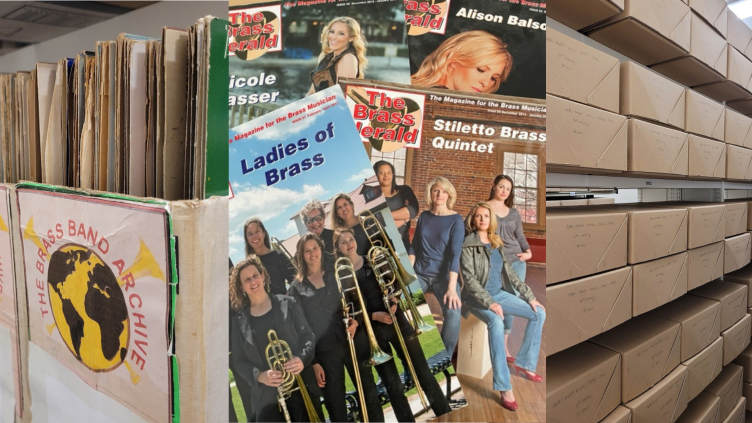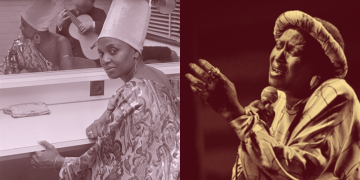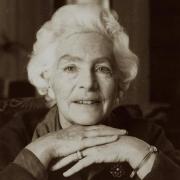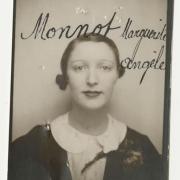You can become a member of BBE either as an organisation or as an individual

Women have not always had a huge presence within the brass banding world. Until fifteen years ago there were still bands who didn’t allow women to play with them. This blog briefly explores a handful of the women, and their music we are lucky enough to hold within the Archive. There will be many women within the archive yet to be discovered, This is only a snapshot of the lives and music of the female banders within our collections.
All the research you will read within this blog has been done by one of our fantastic volunteers, Sarah Crowe (BA (Hons) MRes). A keen brass musician herself, playing with bands since the age of 11. She is currently studying for her PhD which focuses on female banders and their experience in the 20th century, focusing on female military bands linked with the British armed forces. All her research she completes for Brass Bands England adds valuable information to the catalogue, and assists us in exploring our collections.
Maria Cowan
Maria Cowan was the wife of one of Sydney tea merchant James Inglis’ managers, and was tasked with shaping ‘Waltzing Matilda’ into an advertising jingle for his product Billy Tea. Her arrangement was published in July 1903. Cowan’s remains the most well-known arrangement, although the original tune is often credited to another woman – Christina MacPherson of Dagwood Station near Winton. Christina’s family owned the station and Banjo Paterson was staying there when he wrote the poem, which became the song’s lyrics, in 1895. The first iteration of the tune was ‘workshopped’ at Dagwood Station in this year.
Current scholarship believes that MacPherson (who claimed she was ‘no musician’) had more likely done her best to recall and document the tune being played by a band as part of this process. Which she subsequently sent to Harry Nathan, a musician friend of Paterson, to whom he ‘entrusted the musical realisation’ of the song. Nathan’s version pre-dates Cowan’s arrangement by 5 months. Although she appears to have changed it fairly significantly, just as Nathan had added to and embellished the first transcripted melody which was attributed to MacPherson. Therefore, the origins of the song 'Waltzing Matilda’ and Maria Cowan’s role in it are what are best described as being somewhat ‘murky’. They are probably most accurately pieced together from the puzzle pieces of an old Scottish folk tune which it has been suggested is what was actually what MacPherson heard being played, hear it here- The Bonnie Woods Of Craigielea and Waltzing Matilda (youtube.com). A poem by Banjo Paterson and a tune which was worked on and embellished by, in turn, Christine MacPherson, Harry Nathan and eventually Maria Cowan herself. Nothing more could be discovered about Maria Cowan.
Eileen Mehegan
Eileen Mehegan’s composition Lovely Lucan: Dream Waltz is listed in the catalogue of the National Library of Australia as having been published in 1922, belonging to the Kogarah Concert Band, and the parts listed are for a standard brass band. She is listed in their catalogue as being the composer of one other work, Winsome Winnie, which is described as ‘silent film music’ and belonging to the Sydney State Theatre. The Anzacs are recorded as performing Lovely Lucan on a radio broadcast on the 3rd of May 1923, and the piece appears to have been popular, with many performances of it throughout the 1920s as far afield as Canada. She appears to have, like Maria Cowan, been Australian. The only other information discovered about Mehegan were gained from details of her will, which appeared in Australian newspaper ‘The Age’ on 17/11/1980 which states she died on the 9th of June 1978, but the report does not give her date of birth.
Margaret Longstaffe
The competition for the search for an official march for the NFS (National Fire Service) is described in an article in the Liverpool Daily Post in June 1944, with the winning entry being the one sent in by 24 year old Margaret Longstaffe. She was from Leeds, a ‘part-time fire woman’ during the Second World War who was a bank clerk in civilian life. She was awarded £50 for the composition from the NFS, and it was performed at the Royal Albert Hall by the Grenadier Guards Band as part of a concert for the NFS benevolent fund. The story, along with a photograph of Margaret, was even reported nationally in the Daily Mirror, which names her as M.E. Longstaffe. She is described as a singer, who played the piano and violin, with the march being her first composition. The fact she was female, beating male competitors who were awarded consolation prizes, was highlighted in reports in several publications including The Dundee Courier, who stated she had picked the tune out initially with one finger on her piano. The Yorkshire Post provides more details about Margaret and the March, stating she submitted it in piano form and it was then orchestrated with Margaret retaining the copyright.
Apart from discovering that Margaret lost her mother in 1947, and a mention of a birth of a son which appears to have been to Margaret in 1948 (now under her married name of Margaret Thompson), no other conclusive references to Margaret were discovered.
Muriel Watson
The piece in the Archive by Muriel Watson is called in the catalogue Song of the Old Contemptibles. However, the correct title is Sons of the Old Contemptibles (the ‘Old Contemptibles’ were a British Expeditionary Force in 1914). It was written by the prolific husband-and-wife songwriting partnership Muriel Watson, and Jack Denby (along with Everett Lynton) and was published in 1940. The Tonbridge Wells Free Press carried an extensive article on the couple (described as ‘local residents’) in 1946 and their songwriting talents; they were the composers of the ‘top song of the year’. Watson is described as being the composer of the music, and her husband the lyricist. They had been writing for 15 years by this stage and had many hits. They had written songs for films and had compositions recorded by the likes of Vera Lynne, Billy Cotton and Victor Silvester. Billy Cotton’s band can be heard playing the song here.
Katie Moss
The Floral Dance held in the Collection was composed by Moss as a song, inspired by a visit to the Cornish mining village of Helston, in 1911 and first recorded in 1912. In Helston, she witnessed Flora Day celebrations which included ‘the Furry Dance’, which take place annually on the 8th of May. The song gained enormous popularity when it was recorded by Radio 2 DJ Terry Wogan, accompanied by Hanwell Band. Brighouse and Rastrick Band also enjoyed success with the song which they released as a single, and the brass band arrangement was written in the 1970s by their musical director Derek Broadbent. Kate was a prolific performer and professional violinist, pianist, and singer. There are many reports of Kate herself performing in public in the first decades of the twentieth century.
Myriam/Miriam Makeba

Photo credit: Miriam Makeba - Photos courtesy of artpublikamag.com
Pata Pata was the signature song of the exiled anti-apartheid activist Myriam Makeba (1932-2008). The song was originally recorded by Makeba, and her group ‘The Skylarks’ in 1959, but after it was re-released in 1967 in the US it became an international hit. The song and some of her performances can be found on the ARTpublika website. She was married to Black Power activist Kwame Ture/Stokely Charmichael. Her obituary in the Calgary Herald on the 16th of November 2008 examines her long and successful career in detail, saying she was still performing up to her death that year at the age of 75.
Lelia Naylor Morris
Lelia Naylor Morris (1862-1929) wrote more than 1,000 hymns, and texts in her lifetime. Along with Nearer Still Nearer, they are listed here: Mrs. C. H. Morris | Hymnary.org. She is believed to have composed mainly while doing housework, and continued writing even after losing her eyesight at the age of 52. She did this by using an enlarged stave constructed for her for this purpose by her family.
Amy Woodforde-Finden
Amy was born in Valparaiso in 1860. She composed many pieces of music both under her maiden name of Amelia Rose Ward, and her married name. Indian Love Lyrics was self-published in 1902 but later published by Boosey and Co. Kashmiri Song from Indian Love Lyrics became one of the highest selling pieces in sheet music publishing history. The Leeds Mercury on the 27th of July 1923 reports that a film was to be released based on Indian Love Lyrics. Amy died in 1919, aged 59, and is buried in Hampsthwaite, Yorkshire.
Elizabeth Maconchy

Photo credit: Dame Elizabeth Maconchy - Photo courtesy of Art Song Augmented
Elizabeth Maconchy (1907-1994) studied composition at the Royal School of Music. She was taught by, among others, Ralph Vaughn Williams who became a lifelong friend. Her works gained a reputation for being dark, melancholy, disturbing and dissonant. Like other female composers in the early twentieth century, she was subjected to prejudice against women in the industry, which led to her being overlooked for the prestigious Mendelssohn scholarship. Despite this, she won multiple awards for her works, and was a prolific composer of symphonies, ballets, operas and chamber pieces. Her daughter, born in 1947, also became a composer and was awarded the Mendelssohn scholarship which had been denied to her mother.Elizabeth wrote over 200 works in a career spanning more than 60 years.
Marguerite Monnot

Photo credit: Marguerite Monnot - Photo courtesy of Discogs.com
Marguerite Monnot (1903-1961) was a French composer who wrote many songs for Edith Piaf (such as The Poor People of Paris which was given English lyrics by Jack Lawrence in 1956). She made her own debut performance performing Mozart at the age of three and a half, and later studied under Cortot and Boulanger. Monnot successfully collaborated, along with several renowned lyricists, with Edith Piaf throughout her career and built an impressive catalogue of works. She also wrote for the theatre in the form of the musical Irma La Douce, which was an international hit.
All these women and pieces of their music feature in our archive but there will be many more to discover. This is only a snapshot into who they are! Why not take a look at our catalogue to see what gems you can discover? Archives | Heritage Quay
Brass Bands England have several member resources exploring women in banding in the present day; Women in Banding | Brass Bands England (bbe.org.uk) As a member you can watch the BBE webinar: #BreaktheBias of Women in Banding. It explores women in banding from a number of different panellists, including from Brass for Africa and Marrianne Garbutt.
If you are interested in volunteering with us and exploring all the Brass Band heritage the archive has to offer then email archive@bbe.org.uk
References and further reading
Maria Cowan
- Quadrant article on Waltzing Matilda
- The National Film and Sound Archive of Australia - Waltzing Matilda poem
- The National Library of Australia
Muriel Watson
Katie Moss
- Pipecraft - The Floral Dance
- Brighouse & Rastrick Band - A Brief Story of the Floral Dance
- For more information on the original song ‘Floral Dance’ see these articles from The Guardian and Tune Arch
Myriam/Miriam Makeba
Amy Woodforde-Finden
Leila Naylor Morris
Elizabeth Maconchy
- Faber Music
- Art Song Augmented
- Biography of Elizabeth Maconchy
- A list of Elizabeth Maconchy’s compositions can be found at Pytheas Music and a masters dissertation about her here
Maguerite Monnot
- Discogs
- All Music biography
- Discography of American Historical Recordings
- Edith Piaf performing the ‘The Poor People of Paris’
Misc